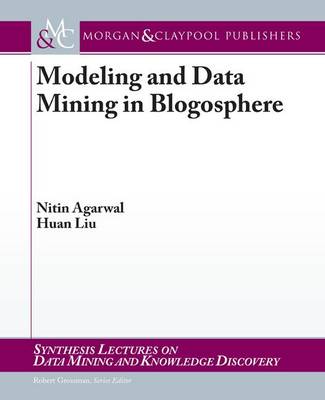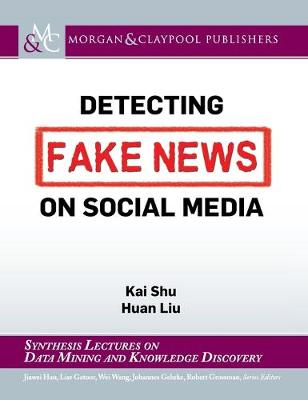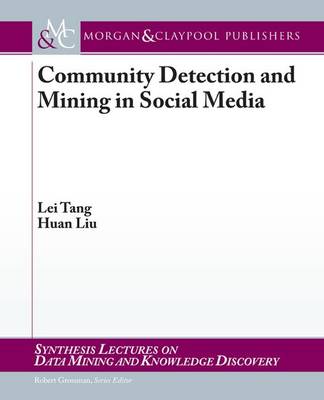Synthesis Lectures on Data Mining and Knowledge Discovery
4 total works
Mining Human Mobility in Location-Based Social Networks
by Huiji Gao and Huan Liu
Published 1 April 2015
In recent years, there has been a rapid growth of location-based social networking services, such as Foursquare and Facebook Places, which have attracted an increasing number of users and greatly enriched their urban experience. Typical location-based social networking sites allow a user to ""check in"" at a real-world POI (point of interest, e.g., a hotel, restaurant, theater, etc.), leave tips toward the POI, and share the check-in with their online friends. The check-in action bridges the gap between real world and online social networks, resulting in a new type of social networks, namely location-based social networks (LBSNs). Compared to traditional GPS data, location-based social networks data contains unique properties with abundant heterogeneous information to reveal human mobility, i.e., ""when and where a user (who) has been to for what,"" corresponding to an unprecedented opportunity to better understand human mobility from spatial, temporal, social, and content aspects. The mining and understanding of human mobility can further lead to effective approaches to improve current location-based services from mobile marketing to recommender systems, providing users more convenient life experience than before. This book takes a data mining perspective to offer an overview of studying human mobility in location-based social networks and illuminate a wide range of related computational tasks. It introduces basic concepts, elaborates associated challenges, reviews state-of-the-art algorithms with illustrative examples and real-world LBSN datasets, and discusses effective evaluation methods in mining human mobility. In particular, we illustrate unique characteristics and research opportunities of LBSN data, present representative tasks of mining human mobility on location-based social networks, including capturing user mobility patterns to understand when and where a user commonly goes (location prediction), and exploiting user preferences and location profiles to investigate where and when a user wants to explore (location recommendation), along with studying a user's check-in activity in terms of why a user goes to a certain location.
This book offers a comprehensive overview of the various concepts and research issues about blogs or weblogs. It introduces techniques and approaches, tools and applications, and evaluation methodologies with examples and case studies. Blogs allow people to express their thoughts, voice their opinions, and share their experiences and ideas. Blogs also facilitate interactions among individuals creating a network with unique characteristics. Through the interactions individuals experience a sense of community.We elaborate on approaches that extract communities and cluster blogs based on information of the bloggers. Open standards and low barrier to publication in Blogosphere have transformed information consumers to producers, generating an overwhelming amount of ever-increasing knowledge about the members, their environment and symbiosis.We elaborate on approaches that sift through humongous blog data sources to identify influential and trustworthy bloggers leveraging content and network information. Spam blogs or splogs is an increasing concern in Blogosphere, which is discussed in detail with the approaches leveraging supervised machine learning algorithms and interaction patterns.We elaborate on data collection procedures, provide resources for blog data repositories, mention various visualization and analysis tools in Blogosphere, and explain conventional and novel evaluation methodologies, to help perform research in the Blogosphere. The book is supported by additional material, including lecture slides as well as the complete set of figures used in the book, and the reader is encouraged to visit the book website for the latest information: http://tinyurl.com/mcp-agarwal.
This book is an accessible introduction to the study of detecting fake news on social media. The concepts, algorithms, and methods described in this book can help harness the power of social media to build effective and intelligent fake news detection systems.
In the past decade, social media is becoming increasingly popular for news consumption due to its easy access, fast dissemination, and low cost. However, social media also enables the wide propagation of "fake news," i.e., news with intentionally false information. Fake news on social media can have significant negative societal effects. Therefore, fake news detection on social media has recently become an emerging research that is attracting tremendous attention. From a data mining perspective, this book introduces the basic concepts and characteristics of fake news across disciplines, reviews representative fake news detection methods in a principled way, and illustrates advanced settings of fake news detection on social media. In particular, the authors discuss the value of news content and social context, as well as important extensions to handle early detection, weakly-supervised detection, and explainable detection.
This is essential reading for students, researchers, and practitioners to understand, manage, and excel in this area. This book is supported by additional materials, including lecture slides, the complete set of figures, key references, datasets, tools used in this book, and the source code of representative algorithms.
In the past decade, social media is becoming increasingly popular for news consumption due to its easy access, fast dissemination, and low cost. However, social media also enables the wide propagation of "fake news," i.e., news with intentionally false information. Fake news on social media can have significant negative societal effects. Therefore, fake news detection on social media has recently become an emerging research that is attracting tremendous attention. From a data mining perspective, this book introduces the basic concepts and characteristics of fake news across disciplines, reviews representative fake news detection methods in a principled way, and illustrates advanced settings of fake news detection on social media. In particular, the authors discuss the value of news content and social context, as well as important extensions to handle early detection, weakly-supervised detection, and explainable detection.
This is essential reading for students, researchers, and practitioners to understand, manage, and excel in this area. This book is supported by additional materials, including lecture slides, the complete set of figures, key references, datasets, tools used in this book, and the source code of representative algorithms.
The past decade has witnessed the emergence of participatory Web and social media, bringing people together in many creative ways. Millions of users are playing, tagging, working, and socializing online, demonstrating new forms of collaboration, communication, and intelligence that were hardly imaginable just a short time ago. Social media also helps reshape business models, sway opinions and emotions, and opens up numerous possibilities to study human interaction and collective behavior in an unparalleled scale. This lecture, from a data mining perspective, introduces characteristics of social media, reviews representative tasks of computing with social media, and illustrates associated challenges. It introduces basic concepts, presents state-of-the-art algorithms with easy-to-understand examples, and recommends effective evaluation methods. In particular, we discuss graph-based community detection techniques and many important extensions that handle dynamic, heterogeneous networks in social media. We also demonstrate how discovered patterns of communities can be used for social media mining. The concepts, algorithms, and methods presented in this lecture can help harness the power of social media and support building socially-intelligent systems. This book is an accessible introduction to the study of \emph{community detection and mining in social media}. It is an essential reading for students, researchers, and practitioners in disciplines and applications where social media is a key source of data that piques our curiosity to understand, manage, innovate, and excel.
This book is supported by additional materials, including lecture slides, the complete set of figures, key references, some toy data sets used in the book, and the source code of representative algorithms. The readers are encouraged to visit the book website for the latest information.
This book is supported by additional materials, including lecture slides, the complete set of figures, key references, some toy data sets used in the book, and the source code of representative algorithms. The readers are encouraged to visit the book website for the latest information.



